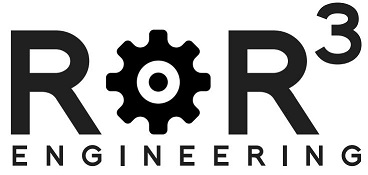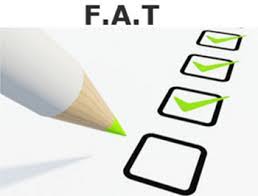Title Page
-
Description of equipment
-
Serial Numbers
-
Conducted on
-
Prepared by
-
Location
-
This document should be used in conjunction with an assessment of the equipment’s compliance with the Provision and Use of Work Equipment (PUWER) regulations 1998
-
PROTOCAL AND PROCEDURE AGREEEMENT
-
Client Representative
-
Supplier Representative
Machine Suitability for FAT
-
To determine that the equipment is complete including all ancillary equipment and change parts.
-
Visual inspection against the technical specifications including any agreed changes.
-
Check the physical dimensions including guards against the layout drawing.
-
All guarding in place and properly fastened.
-
HMI screen in correct local language.
Machine Suitability for end use
-
To verify that the machine can be run in the customer-required position and has all the components in place as outlined in the machine specification.
-
A. Check the physical dimensions including guards against the layout drawing.
-
B. Check all machine components on the machine comply with relevant electrical/mechanical specifications.
-
Operation through Main screen.
-
Variables are easy to understand and clearly describe their function.
-
All peripheral alarms function properly
-
Pushbuttons around machine function properly.
-
Product size screen contains all change settings and changeparts.
-
Recipes loaded in the HMI
General Appearance
-
To verify the machine meets the minimum standard of appearance required.
-
To be completed at the beginning of the trials:
A. Examine the whole machine for scratches, damage or cracks
B. Gland contact points are smooth and burr free.
C. Inspect all bolts including domed nuts. -
Equipment is clean.
-
All guarding in place and properly fastened.
-
Gauges are visible, accessible and properly mounted.
-
No sharp edges and smooth welds.
-
No visible damage on frame, guarding and other components.
-
Gearboxes and motors are properly mounted, no signs of leakage.
-
All changeover settings have rulers or scales including indicator for proper setting.
-
No trip points around the machine
-
No outsticking components / machine parts in workway of operator
-
All format parts are identified with proper identification
Electrical check
-
Verification of all electrical wiring & components meets Clients electrical standards and codes of practice.
-
Using Regulatory standards and any variants agreed. Check all electrical components wiring and ancillary equipment and mountings.
-
Each input and output must be correctly wired, with no spare I/O being wired to devices. The action of each input/outputs must correspond with the schedules. All spare wires terminated.
• All components comply with agreed standard.
• All wiring is suitably protected and routed.
• All protection is to the agreed IP rating.
• All sensors are suitably mounted.
• Control panel is built and constructed to agreed specification.
• All earth straps are in place and secure. -
Panels are clean and free from debris and any metal filings.
-
Wires properly connected and installed.
-
Wires and terminals clearly marked and identified.
-
Note down voltage marking on identification tag: V, Hz.
-
All components identified corresponding to schematics.
-
Electrical schematics are provided in the cabinet.
-
All doors are clearly marked and identified (check display vs actual door numbering.
Mechanical check
-
To verify that all mechanical components meet Clients mechanical standards and codes of practice.
-
Using the Clients mechanical standards and any variation agreed check all mechanical components for compliance secure fixing and correct positioning
-
All components comply to standards.
-
All components are fit for purpose.
-
All bearings are either sealed for life or centrally lubricated as agreed.
-
All bearings to be agreed and gear boxes to be filled to the correct level with the agreed lubricants.
-
All serviceable items to be easily accessible for maintenance.
-
All pneumatic / hydro filter and top up bottles to be easily accessible.
Machine guarding, unlock & safety devices
-
Machine guarding is suitable and that all interlock and safety devices function as agreed, and indicate correctly.
-
Test should be carried out with no product.
1) Complete PUWER.
2) Activate the E-stop,
3) Check and record message on the panel.
4) Check operation of the safety unit
5) Pull the e-stop out
6) Check operation of the safety unit
7) Attempt to restart machine in each operating mode -
E-stop, switch on machine, randomly activate an emergency stop. Machine stops, all drives switch of, pneumatics go to safe state, message on display.
-
Unlock e-stop, reset alarm and restart machine, machine starts reliable
-
Doors are locked during normal operation
-
Activate door “door open request” machine stops before opening doors
-
Close door command works reliable, machine will not start when not properly closed.
-
Main power switch available.
-
Hotmelt unit is safely mounted, no change of injury of operator
-
Air supply can be locked out
-
Air dump valve works reliable
-
Machine is according to CE covered.
-
All dangerous points are covered or protected and protecting the operators against injury.
Signage and Labelling
-
To verify the machine has adequate signage
This includes,
A. Earth labels
B. CE labels
C. Machine identification plate
D. E-Stop labels
E. Warning labels
F. Wire Identification
G. Sensors, Actuators, Pipe work
H. Lamps, Beacons
I. Machine asset plate -
All appropriate warning signs are on the machine in the correct local language.
-
All buttons labelled and in correct language.
Dry Tests
-
To ensure machine functions smoothly.
- Operate machine at low speed
- Run machine at full speed including any over speed
- Check for vibration or excessive noise -
Machine starts in sequence.
Machine running
-
To ensure that the machine operates as per the tender and specification document
-
A – Demonstrate the machine functionality
B – Check that the machine functions properly at agreed maximum and minimum speeds
C – Demonstrate that change over can be achieved within agreed times
D – Ensure that all machine controls are easily accessible
E - Witness all formats running.
F – Ensure that whilst machine is running it is free, smooth and free from vibration -
Packs are positioned correctly in SmartTrack.
-
Packs are correctly picked up.
-
Pick up head holds packs correctly during flight.
-
Packs are correctly placed in case (see product tests for more details).
-
Cases are correctly taken from magazine.
-
Casesblanks are folded correctly and glued properly.
-
Cases are square (measure diagonals).
-
After filling cases are closed correctly.
-
During erecting, filling and closing cases are not damaged.
Recovery from Power Failure
-
To verify that the system recovers in a controlled fail-safe manner after a power failure.
-
A - Run machine.
B -Run the machine as normal, and turn the power off while the machine is running.
Turn the power back on again the machine should not restart.
C - Repeat tests (A) and (B), but with the machine stationary.
D - Restart machine.
E - Repeat the above action to check machine functionality. -
Machine should power up as normal with no faults.
Documentation
-
To verify that all required documented is in place.
-
To sight and review the following files
1. All parameter and register settings logged onto program, Disk and hard copy placed in Manual
2. 3 copies (plus USB/CD version) of the electrical / pneumatic drawings checked and modified if necessary.
3. Program backed up on disk.
4. 3 copies (plus USB/CD version) Machine manuals, (operation and maintenance) in correct language. (English)
5. Second copy of Tech file supplied. Tech files signed by manufacturer’s rep.
6. CE marked and a certificate of conformity. Noise and EMC test certificates included
7. Replacement parts list. -
Hard and soft copy of manuals provided.
-
Program backed up.
-
Recommended spare parts list.










